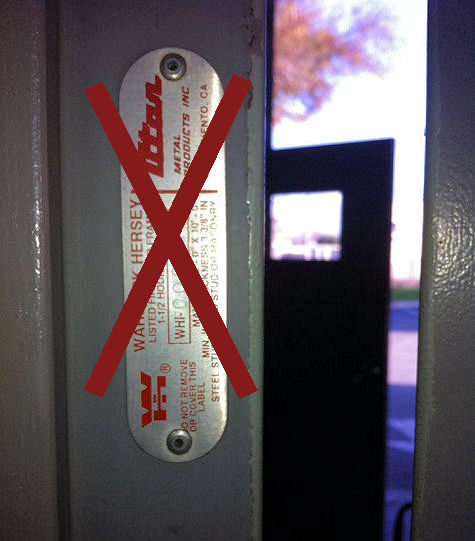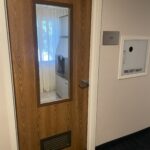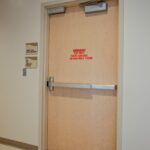 It’s hard to believe that it has been almost two years since I wrote about the Joint Commission’s position that fire door assemblies in health care must match what is required for the location where they are installed. Their view was that a fire door assembly could not have a higher rating than what was needed for the wall where the assembly was located, and that a fire door assembly could not be installed in a location where a fire door assembly was not required.
It’s hard to believe that it has been almost two years since I wrote about the Joint Commission’s position that fire door assemblies in health care must match what is required for the location where they are installed. Their view was that a fire door assembly could not have a higher rating than what was needed for the wall where the assembly was located, and that a fire door assembly could not be installed in a location where a fire door assembly was not required.
When I discussed this with NFPA staff, their opinion was that NFPA 101 does not prohibit fire door assemblies from being installed where they are not required, and that the required ratings stated in the code are a minimum requirement; a higher rating is acceptable. I have never received further clarification from CMS on this issue, but it hasn’t come up much lately. I don’t know if it is being enforced by the Joint Commission – if you know…tell us!
It is not uncommon for a door and/or frame with a fire label to be installed where a fire door assembly is not required. Although this could cause some confusion when it’s time for a fire door inspection, I don’t see a major life-safety problem with this practice. It doesn’t seem plausible to me that a building occupant would see a 90-minute label on a fire door and assume that they will be protected for 90 minutes (even if the wall doesn’t offer this level of protection). Reading the fine print on a fire door label and making life safety decisions based on that is much less likely than a building occupant seeing sprinkler heads and assuming that there is an automatic fire sprinkler system in the building. (Note: This is my opinion and I am not an AHJ.)
If an AHJ does enforce this requirement and order unnecessary fire door labels to be addressed, what’s the proper protocol? One company introduced decommissioning labels, and began offering a service to decommission fire door assemblies and install the labels. However, the Office of the State Fire Marshal in Kansas (where the company is located) issued a bulletin stating that this practice is unacceptable. It’s best to check with the local AHJ before embarking on a course of action.
You need to login or register to bookmark/favorite this content.






Ok someone needs to write “The Code of Common Sense”
1. You are allowed to install higher rated doors, if you want to spend the money.
2. If not a rated opening, you can do what ever you want, to include Xing the rating label.
Not sure about the possible commission rule, or requiring someone to spend a lot of money to say that is not a rated wall.
Anyway, good article.
Lori – TJC and CMS both have taken a more logical approach over time (thankfully). The guidance we got from them is that as long as the life safety drawings are accurate, then only the fire doors located in the rated barriers need to be included in the fire door inventory/testing program. Doors that are not located in rated barriers per the drawings (but may have labels indicating a fire protection rating) do not need to be inspected/tested as a fire door….. although they do recommend that these doors (corridor doors, smoke barrier doors, etc.) be included in a facility’s maintenance program since they play an important role in supporting a hospital’s “defend in place” approach.
Hi Paul –
That’s great news! Is there anything in writing from CMS or the Joint Commission? Because unfortunately their previous position was documented in writing – at least online.
– Lori
Lori – I do have it in writing (via email) from CMS – the email describes what I mentioned in my previous email. As much as I would like to, I really do not feel comfortable sharing that email in this forum, but I will say that I am not aware of any of our clients getting cited for having a fire door installed in a barrier that’s not a required rated barrier. If any of your readers get cited for this, we will be happy to help them challenge it if they so desire.
I have seen fire protection engineer use a screwdriver to yank off the FDL.
In hospital construction, spaces named “Unassigned” or “Shell” are assumed to be de facto storage rooms and require one-hour enclosure with 45 min door. When the space is built out with a nonhazardous use the original labeled door may remain in place even though not required. I have not had an AHJ challenge this practice.
I have fallen prey to this (and similar) conditions. The problem is during periodic or regularly scheduled inspections by the Fire Marshal’s office. The inspector will arrive on site and observe things like a labeled door being held open or modifications to the non-rated wall that wouldn’t necessarily be allowed if it carried a required rating. An inspector isn’t going to back and look at permit sets, or listen to a building owner try and convince him otherwise.
I’ve had similar disagreements with inspectors over exits that weren’t required to have exit devices (due to occupant load) but were required to have exit lights (due to SF of the room) – a perfect example being a high school science lab. Inspectors are so used to seeing exit lights and exit devices together that when they see one without the other they immediately think “violation”.
I’m not trying to say inspectors are dumb or irrational. They’re just trying to do their job and protect life and property.
Installing a fire-rated door when it is not needed can have intentioned consequences. Often when we are doing renovation work in an existing building, we look to see if the wall is fire-rated by looking for door labels. If the door is labeled we assume the wall is rated and treat the penetrations accordingly. This can add a lot of cost to a project that is not necessary.
Lori – We are based in MI and during our AHSE state chapter conference meeting a few weeks back, we had a panel discussion and this exact topic was addressed during this session. The panel consisted of our Bureau of Fire Services, State Health Facilities representative, TJC representative and an outside consultant, briefing of the comments are as such:
– BFS: as noted above, they are concerned with the rated assemblies indicated only on the life safety drawings, which are the assemblies that are designed and are intended as rated wall assemblies. Doors that are rated, but fall outside of rated wall assemblies they are not concerned with.
– TJC: Mentioned that the LS drawings would be the key for locating the rated assemblies, but their current stance would require those outside of rated assemblies if labeled to be treated as a rated opening. Their solution however for this was to paint the labels so that they are not clearly visible to the public. They had mentioned that this was the communication that they were putting out to their staff. The question was raised about this being documented as a viable solution and the response was that there has not been anything put in writing at this point.
Not sure if this helps or muddies the waters, but wanted to pass along what we learned this past week.
Thanks Eric! That’s great information!
– Lori
I think the Kansas Fire Marshal simply stated that you can’t just decommission a fire-rated door in a rated wall without going through the plan review process. You have to have a change of occupancy, not just a desire to avoid inspection and maintenance.
Dennis is right-on – we often look at the door labels to help in understanding the ratings of the walls. Hard to tell when an existing wall has 90 minute, 45 minute and non-labeled doors separating the same spaces, though!
See nfpa.org/101 and look at the next edition:
https://submittals.nfpa.org/TerraViewWeb/ViewerPage.jsp?id=101-2018.ditamap&toc=false&draft=true
It has the proposed revisions to NFPA 101 paragraph 4.6.12.3 and A.4.6.12.3. “Obvious to the public” has been changed to sprinklers, alarm sytems, standpipes and fire extinguishers, and the annex specifically addresses fire doors and frames. This is due to the concerns stated here..and to be clear that non-required fire doors and frames are not required to be maintained in proper order.
You can refer your AHJs to the NFPA website so they can see for themselves that the 2015 change was supposed to clarify that, and they are attempting to clarify it further.
Thanks Liane!
– Lori